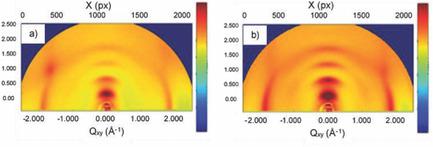当前位置:
X-MOL 学术
›
Adv. Mater. Interfaces
›
论文详情
Our official English website, www.x-mol.net, welcomes your
feedback! (Note: you will need to create a separate account there.)
Insights into the Oxidant/Polymer Interfacial Growth of Vapor Phase Polymerized PEDOT Thin Films
Advanced Materials Interfaces ( IF 4.3 ) Pub Date : 2018-06-25 , DOI: 10.1002/admi.201800594 Anirudh Sharma 1, 2 , Gunther Andersson 1 , Jonathan Rivnay 3 , Jason F. Alvino 4 , Gregory F. Metha 4 , Mats R. Andersson 1 , Kamil Zuber 5 , Manrico Fabretto 5
Advanced Materials Interfaces ( IF 4.3 ) Pub Date : 2018-06-25 , DOI: 10.1002/admi.201800594 Anirudh Sharma 1, 2 , Gunther Andersson 1 , Jonathan Rivnay 3 , Jason F. Alvino 4 , Gregory F. Metha 4 , Mats R. Andersson 1 , Kamil Zuber 5 , Manrico Fabretto 5
Affiliation

|
The vapor phase polymerization (VPP) technique is used to produce thin films of poly(3,4‐ethylenedioxythiopene) (PEDOT) in which the Fe(III)Tosylate oxidant is altered. The oxidant is changed with the addition of an amphiphilic co‐polymer having different molecular weights, namely 2800 Da. and 5800 Da. Resulting PEDOT films produce conductivities of ≈1500 and ≈3000 S cm−1 respectively. Small angle X‐ray diffraction (SA‐XRD) indicates that the oxidant incorporating the larger molecular weight co‐polymer possesses ordered structure and that this in turn helps “template” the PEDOT during film formation. The structure and composition of the bottom (i.e. initial film formation) and top (i.e. final film formation) PEDOT surfaces are studied using surface sensitive analytical techniques; small angle X‐ray diffraction (SA‐XRD), ultraviolet photoelectron spectroscopy (UPS), 2D grazing incidence X‐ray diffraction (2D‐GIXD), metastable induced electron spectroscopy (MIES) and neutral impact collision ion scattering spectroscopy (NICISS). The results indicate that the increase in conductivity using the larger molecular weight co‐polymer additive is due to the film having larger lamella‐ and π‐stacking regions in addition to doping levels which remain unchanged throughout film formation. These conclusions are further supported by results obtained on a model PEDOT:Tosylate system using density functional theory (DFT) calculations.
中文翻译:

气相聚合PEDOT薄膜的氧化剂/聚合物界面生长的真知灼见
气相聚合(VPP)技术用于生产聚(3,4-亚乙基二氧噻吩)(PEDOT)薄膜,其中的甲苯磺酸铁(III)氧化剂发生了变化。通过添加分子量不同的两亲共聚物(即2800 Da)来改变氧化剂。和5800 Da。所得的PEDOT膜产生的电导率约为1500和≈3000 S cm -1分别。小角度X射线衍射(SA-XRD)表明,掺入较大分子量共聚物的氧化剂具有有序结构,这反过来又有助于在成膜过程中“模板化” PEDOT。底部(即初始成膜)和顶部(即最终成膜)PEDOT表面的结构和组成使用表面敏感性分析技术进行研究;小角X射线衍射(SA-XRD),紫外光电子能谱(UPS),二维掠入射X射线衍射(2D-GIXD),亚稳感应电子光谱(MIES)和中性碰撞碰撞离子散射光谱(NICISS)。结果表明,使用较大分子量的共聚物添加剂可提高电导率,这是由于薄膜具有较大的薄片和π堆叠区域,而且掺杂水平在整个薄膜形成过程中均保持不变。使用密度泛函理论(DFT)计算在模型PEDOT:Tosylate系统上获得的结果进一步支持了这些结论。
更新日期:2018-06-25
中文翻译:

气相聚合PEDOT薄膜的氧化剂/聚合物界面生长的真知灼见
气相聚合(VPP)技术用于生产聚(3,4-亚乙基二氧噻吩)(PEDOT)薄膜,其中的甲苯磺酸铁(III)氧化剂发生了变化。通过添加分子量不同的两亲共聚物(即2800 Da)来改变氧化剂。和5800 Da。所得的PEDOT膜产生的电导率约为1500和≈3000 S cm -1分别。小角度X射线衍射(SA-XRD)表明,掺入较大分子量共聚物的氧化剂具有有序结构,这反过来又有助于在成膜过程中“模板化” PEDOT。底部(即初始成膜)和顶部(即最终成膜)PEDOT表面的结构和组成使用表面敏感性分析技术进行研究;小角X射线衍射(SA-XRD),紫外光电子能谱(UPS),二维掠入射X射线衍射(2D-GIXD),亚稳感应电子光谱(MIES)和中性碰撞碰撞离子散射光谱(NICISS)。结果表明,使用较大分子量的共聚物添加剂可提高电导率,这是由于薄膜具有较大的薄片和π堆叠区域,而且掺杂水平在整个薄膜形成过程中均保持不变。使用密度泛函理论(DFT)计算在模型PEDOT:Tosylate系统上获得的结果进一步支持了这些结论。











































 京公网安备 11010802027423号
京公网安备 11010802027423号